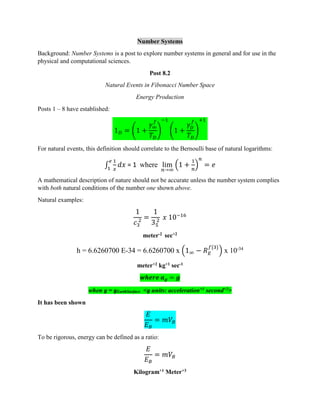Report
Share
Download to read offline

More Related Content
What's hot
What's hot (17)
Calculating transition amplitudes by variational quantum eigensolvers

Calculating transition amplitudes by variational quantum eigensolvers
Calculus in real life (Differentiation and integration )

Calculus in real life (Differentiation and integration )
Similar to Post_Number Systems_8.2
Similar to Post_Number Systems_8.2 (20)
ADAPTIVE STABILIZATION AND SYNCHRONIZATION OF LÜ-LIKE ATTRACTOR

ADAPTIVE STABILIZATION AND SYNCHRONIZATION OF LÜ-LIKE ATTRACTOR
Hyperon and charmed baryon masses and axial charges from Lattice QCD

Hyperon and charmed baryon masses and axial charges from Lattice QCD
More from Marc King
More from Marc King (13)
Post_Number Systems_8.2
- 1. Number Systems Background: Number Systems is a post to explore number systems in general and for use in the physical and computational sciences. Post 8.2 Natural Events in Fibonacci Number Space Energy Production Posts 1 – 8 have established: 1 𝐷 = (1 + 𝛾∞ 𝑓 𝑇𝐷 ) −1 (1 + 𝛾 𝐷 𝑓 𝑇𝐷 ) +1 For natural events, this definition should correlate to the Bernoulli base of natural logarithms: ∫ 1 𝑥 𝑑𝑥 𝑒 1 = 1 where lim 𝑛→∞ (1 + 1 𝑛 ) 𝑛 = 𝑒 A mathematical description of nature should not be accurate unless the number system complies with both natural conditions of the number one shown above. Natural examples: 1 𝑐3 2 = 1 35 2 𝑥 10−16 meter-2 sec+2 h = 6.6260700 E-34 = 6.6260700 x (1∞ − 𝑅 𝐸 𝑓{3} ) x 10-34 meter+2 kg+1 sec-1 𝒘𝒉𝒆𝒓𝒆 𝒂 𝒈 = 𝒈 when g = gEarthSurface <g units: acceleration+1 second+2> It has been shown 𝐸 𝐸 𝐵 = 𝑚𝑉𝐵 To be rigorous, energy can be defined as a ratio: 𝐸 𝐸 𝐵 = 𝑚𝑉𝐵 Kilogram+1 Meter+3
- 2. Define 𝐸 𝐸 𝐵𝐷 = (𝑘𝑎𝑝𝑝𝑎) 𝐷 𝑛 𝑥 𝑐 𝐷 1 𝐷 = (1 + 𝛾∞ 𝑓 𝑇𝐷 ) −1 (1 + 𝛾 𝐷 𝑓 𝑇𝐷 ) +1 𝑒1 = 0 𝑒2 = 1 𝑒3 = 𝑒 𝑒5 = 𝑒 𝑓{3} 𝒆 𝑫 = 𝒆 𝑫−𝟏𝑫 𝒇{𝑫−𝟏𝑫} 𝑚 𝐷 = (1 − 𝑅 𝐸 𝑓{𝐷} ) 𝑒 𝐷 𝐷 𝐷+1𝐷 𝒉 𝟓 = 𝒎 𝟑 𝒉 𝟑 + 𝒃 𝟑 And so on for D = F(n). Post 8.2.1 is intended to clarify energy production in Fibonacci energy space.